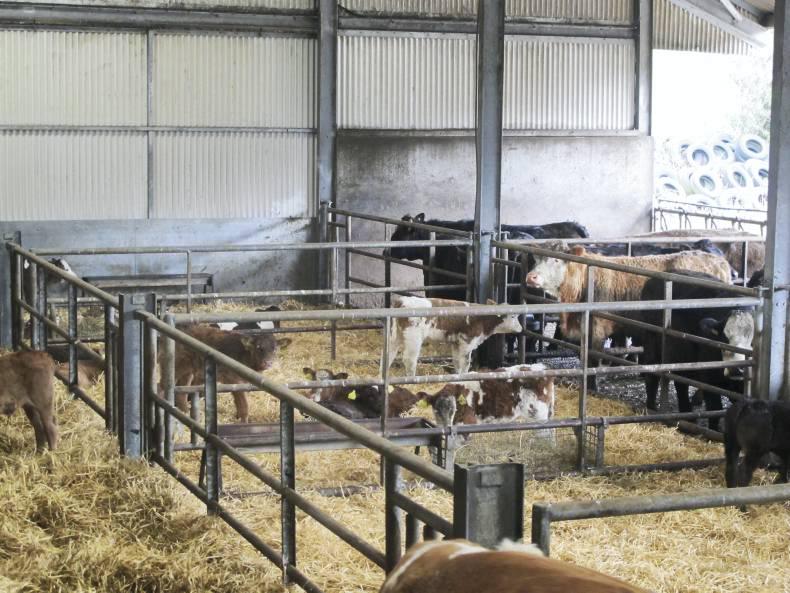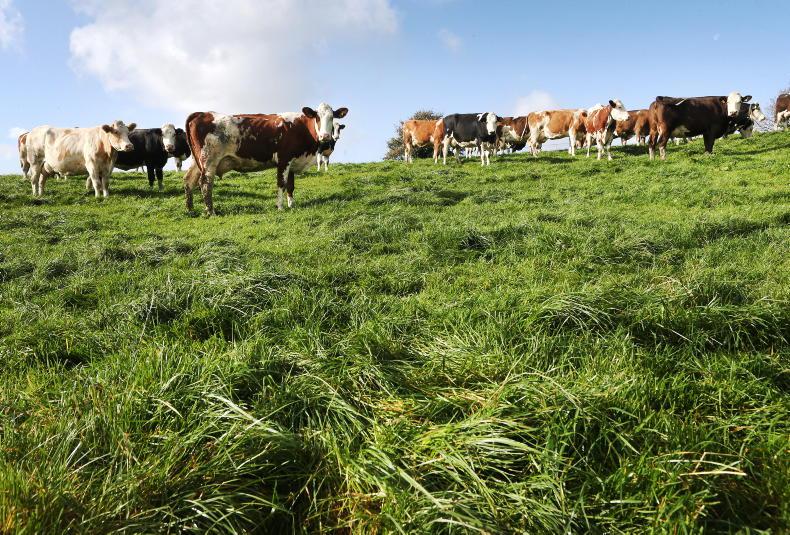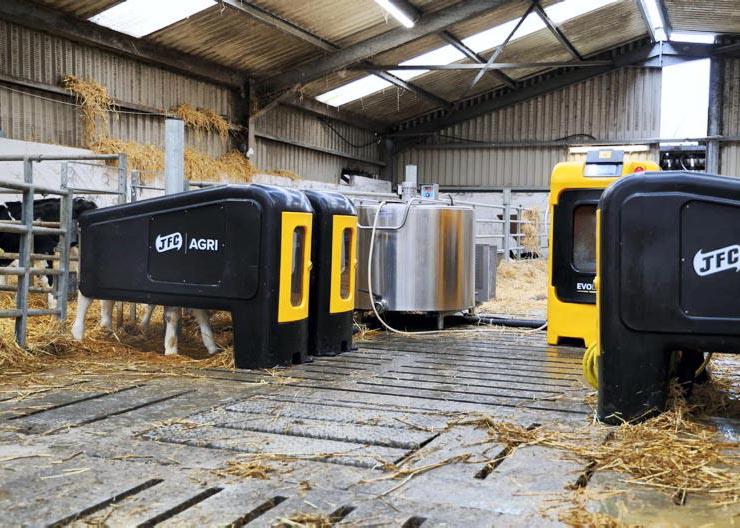In the past few years, some farmers calving in the autumn have pulled calving back a little to have cows calved outdoors, so as to avoid having young calves indoors. This practice works well, as calves are stronger and fit for more disease challenges at housing. However, those who calve indoors from October onwards can also avoid disease risks and ensure calves remain healthy by getting the basics right on management and hygiene.
Body condition Score
One issue that frequently arises with autumn-calving cows that are dry at grass during the summer months is that they can be carrying too much flesh. Cows should have a body condition score of 3 at calving in the autumn. Cows with a BCS of over 3.5 can have increased levels of fatty deposits in the birth canal, which could hinder calving.
If cows are carrying too much flesh, or need feeding, the target BCS should be achieved about six to eight weeks prior to calving. Over-feeding thin cows in the last six weeks of pregnancy can lead to larger calf size, which could increase calving difficulty.
In addition to calving issues, the BCS at calving – and more importantly the reduction of BCS from calving to breeding – can have a major impact on length of the anoestrus period and can subsequently impact conception rates.
Minerals
As always, the first step is ensuring that pre-calving minerals are fed well in advance of calving. The advice is to feed pre-calving minerals for a minimum of six weeks prior to calving. This will help to ensure calves are more vigorous at calving and that there is less risk of cows having retained cleanings (placenta).
If you have a problem on the farm with minerals, then it may be worth having a random group of cows’ blood sampled and analysed to identify major mineral deficiencies. In extreme cases, it may be necessary to have a specially-blended mineral mix formulated for the farm, or opt for a more expensive mineral supplementation programme.
Calving facilities
Having adequate handling facilities for calving is crucial. A good rule of thumb for a herd where there is a tight calving pattern is to have at least one calving pen for every 15 cows.
Having at least one calving pen with a head restraint and calving gate can help improve safety and reduce the risk of injury for both the calf and the cow. Most calving gates will allow for certain sections to be opened, which can help to restrain a cow during a caesarean section, or to allow the calf to suckle the cow while she is restrained.
Safety at calving is crucial. Cows can become extremely agitated around calving time. For that reason, farmers should exhibit extreme caution at all times during calving.
Cleanliness
Cleanliness is critical to attaining subsequent fertility. Harmful pathogens and bacteria can enter the birth canal when cows are being handled at calving. Farmers should ensure they have protective gloves and lubricant on hand in advance of calving.
Where a calving jack is being used, ensure both the jack and the ropes have been cleaned thoroughly and disinfected prior to use. Continue this practice between calvings.
Calving pens should be cleaned out after each calving and disinfected. Once dry they should be bedded with approximately six inches of straw to ensure a clean, dry bed for the cow and calf.
After calving
Once the calf has been taken from the cow, the first port of call should be to ensure the calf is breathing correctly. Calves that sound “croaky” when breathing may have fluid in their lungs or airways. In such a case, the calf should be hung upside down by its rear legs for a minute or two to allow the fluid to drain.
This can be done easily by using the ropes of the calving jack on the hind feet of the calf, placing the head piece of the calving jack on the ground and jacking the calf into an upright position. Where there is no signs of fluid on the lungs, do not attempt to hang the calf over a gate or upside down.
The naval of the calf is the next area that needs attention. It should be disinfected using iodine to reduce the risk of naval/joint-ill.
Retained placenta and discharge
Cows should clean naturally within 24 hours of birth. If a cow has a retained placenta thereafter, consult your vet. Retained cleanings can result in infections that will reduce fertility substantially. If cows have retained placenta they require attention. Also, any cows that have a dirty or smelly discharge in the weeks after calving need to be treated, as this will delay their coming in heat and can affect subsequent fertility.
For those who operate a tight calving pattern, quick attention to retained placenta and intra uterine infections could result in reducing the culling rate due to infertility. The quicker you get these cows back cycling, the higher the chance of keeping them in the herd.
Avoiding scour in autumn-born calves
In most cases, vaccinating the cow before calving will ensure that adequate levels of antibodies are available to pass to the calf. However, the passage of these maternal antibodies depends on the level and timing of colostrum intake with the calf. The calf’s ability to absorb antibodies across the gut wall reduces gradually from six hours to 12 hours after birth.
Even without the use of vaccines, ensuring the calf gets adequate levels of colostrum from its mother quickly after birth will help boost the calf’s immune system and could also help reduce the risk of scour dramatically.
Symptoms and treatments
Symptoms of scour include watery faeces, as well as sunken eyes and drooping ears as the disease progresses. The animal will also appear lethargic and will have a decreased appetite.
Where suckler cows and calves are housed and a calf shows signs of scour, the calf should be isolated to avoid spreading the infection to the other calves. Quick removal of sick calves will help to minimise the rate of spread of the illness to other healthy calves. The calf should then be treated with veterinary supervision.
Where there is no additional housing to allow scouring calves and cows to be isolated, turning them out to grass may be more beneficial.
Scour samples should be taken to identify the pathogen, as the problem may continue in other calves.
The least prevalent types of scour are ones caused by bacteria. So in most cases, antibiotics are of little benefit. The most common causes of calf scour are parasites, namely cryptosporidiosis and coccidiosis. However, viruses such as rotavirus and coronavirus can also cause scour.
Hygiene
Calf scours are generally passed on through the environment. Calf creep areas and calf pens should be bedded daily to ensure calves have a clean dry bed and to ensure that contact with faeces is kept to a minimum. A good rule of thumb when assessing whether or not enough straw is being used is to kneel on the bedding. If sufficient straw is being used, the bedding will be dry.
Read more
Focus: Winter animal health
In the past few years, some farmers calving in the autumn have pulled calving back a little to have cows calved outdoors, so as to avoid having young calves indoors. This practice works well, as calves are stronger and fit for more disease challenges at housing. However, those who calve indoors from October onwards can also avoid disease risks and ensure calves remain healthy by getting the basics right on management and hygiene.
Body condition Score
One issue that frequently arises with autumn-calving cows that are dry at grass during the summer months is that they can be carrying too much flesh. Cows should have a body condition score of 3 at calving in the autumn. Cows with a BCS of over 3.5 can have increased levels of fatty deposits in the birth canal, which could hinder calving.
If cows are carrying too much flesh, or need feeding, the target BCS should be achieved about six to eight weeks prior to calving. Over-feeding thin cows in the last six weeks of pregnancy can lead to larger calf size, which could increase calving difficulty.
In addition to calving issues, the BCS at calving – and more importantly the reduction of BCS from calving to breeding – can have a major impact on length of the anoestrus period and can subsequently impact conception rates.
Minerals
As always, the first step is ensuring that pre-calving minerals are fed well in advance of calving. The advice is to feed pre-calving minerals for a minimum of six weeks prior to calving. This will help to ensure calves are more vigorous at calving and that there is less risk of cows having retained cleanings (placenta).
If you have a problem on the farm with minerals, then it may be worth having a random group of cows’ blood sampled and analysed to identify major mineral deficiencies. In extreme cases, it may be necessary to have a specially-blended mineral mix formulated for the farm, or opt for a more expensive mineral supplementation programme.
Calving facilities
Having adequate handling facilities for calving is crucial. A good rule of thumb for a herd where there is a tight calving pattern is to have at least one calving pen for every 15 cows.
Having at least one calving pen with a head restraint and calving gate can help improve safety and reduce the risk of injury for both the calf and the cow. Most calving gates will allow for certain sections to be opened, which can help to restrain a cow during a caesarean section, or to allow the calf to suckle the cow while she is restrained.
Safety at calving is crucial. Cows can become extremely agitated around calving time. For that reason, farmers should exhibit extreme caution at all times during calving.
Cleanliness
Cleanliness is critical to attaining subsequent fertility. Harmful pathogens and bacteria can enter the birth canal when cows are being handled at calving. Farmers should ensure they have protective gloves and lubricant on hand in advance of calving.
Where a calving jack is being used, ensure both the jack and the ropes have been cleaned thoroughly and disinfected prior to use. Continue this practice between calvings.
Calving pens should be cleaned out after each calving and disinfected. Once dry they should be bedded with approximately six inches of straw to ensure a clean, dry bed for the cow and calf.
After calving
Once the calf has been taken from the cow, the first port of call should be to ensure the calf is breathing correctly. Calves that sound “croaky” when breathing may have fluid in their lungs or airways. In such a case, the calf should be hung upside down by its rear legs for a minute or two to allow the fluid to drain.
This can be done easily by using the ropes of the calving jack on the hind feet of the calf, placing the head piece of the calving jack on the ground and jacking the calf into an upright position. Where there is no signs of fluid on the lungs, do not attempt to hang the calf over a gate or upside down.
The naval of the calf is the next area that needs attention. It should be disinfected using iodine to reduce the risk of naval/joint-ill.
Retained placenta and discharge
Cows should clean naturally within 24 hours of birth. If a cow has a retained placenta thereafter, consult your vet. Retained cleanings can result in infections that will reduce fertility substantially. If cows have retained placenta they require attention. Also, any cows that have a dirty or smelly discharge in the weeks after calving need to be treated, as this will delay their coming in heat and can affect subsequent fertility.
For those who operate a tight calving pattern, quick attention to retained placenta and intra uterine infections could result in reducing the culling rate due to infertility. The quicker you get these cows back cycling, the higher the chance of keeping them in the herd.
Avoiding scour in autumn-born calves
In most cases, vaccinating the cow before calving will ensure that adequate levels of antibodies are available to pass to the calf. However, the passage of these maternal antibodies depends on the level and timing of colostrum intake with the calf. The calf’s ability to absorb antibodies across the gut wall reduces gradually from six hours to 12 hours after birth.
Even without the use of vaccines, ensuring the calf gets adequate levels of colostrum from its mother quickly after birth will help boost the calf’s immune system and could also help reduce the risk of scour dramatically.
Symptoms and treatments
Symptoms of scour include watery faeces, as well as sunken eyes and drooping ears as the disease progresses. The animal will also appear lethargic and will have a decreased appetite.
Where suckler cows and calves are housed and a calf shows signs of scour, the calf should be isolated to avoid spreading the infection to the other calves. Quick removal of sick calves will help to minimise the rate of spread of the illness to other healthy calves. The calf should then be treated with veterinary supervision.
Where there is no additional housing to allow scouring calves and cows to be isolated, turning them out to grass may be more beneficial.
Scour samples should be taken to identify the pathogen, as the problem may continue in other calves.
The least prevalent types of scour are ones caused by bacteria. So in most cases, antibiotics are of little benefit. The most common causes of calf scour are parasites, namely cryptosporidiosis and coccidiosis. However, viruses such as rotavirus and coronavirus can also cause scour.
Hygiene
Calf scours are generally passed on through the environment. Calf creep areas and calf pens should be bedded daily to ensure calves have a clean dry bed and to ensure that contact with faeces is kept to a minimum. A good rule of thumb when assessing whether or not enough straw is being used is to kneel on the bedding. If sufficient straw is being used, the bedding will be dry.
Read more
Focus: Winter animal health









SHARING OPTIONS